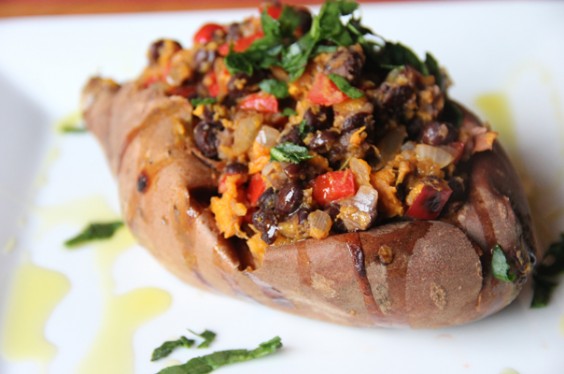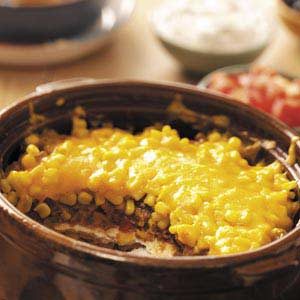Mexican Recipes Biography
Source Link Goggle.com.pk
Chelsie enjoys cooking authentic and traditional Mexican dishes in her own kitchen. She has spent the last 5 years at About.com sharing her recipes and passion for Mexican Cuisine with her readers. Chelsie travels to Mexico frequently and shops at the neighborhood panaderias, carnicerias and farmer's markets in her own neighborhood and loves to use locally grown, fresh ingredients to create new recipes and improve family favorites. She is excited to share her recipes and knowledge with you to help you learn how to cook Mexican food.
Experience:
Chelsie grew up surrounded by great cooks in her family and learned from a young age about spices and flavorings unique to Mexican food. As a young adult, she made several missionary trips to villages in Mexico during which she had a chance to discuss the local dishes and cooking techniques with the native people. She has also spent time in Chile which further enhanced her knowledge of Latin Cuisine. She has also been a guest speaker on the topic of cooking Mexican cuisine at local community colleges and more recently, elementary schools.
Chelsie is also the author of "Mexican Cooking" a cookbook featuring traditional Mexican dishes.
There are so many wonderful aspects to Mexican cuisine with all of its delicious spices, flavors and rich history. Mexican food is a delicious blend of native Aztec and Mayan ingredients with Spanish influences. I hope that my recipes and informative articles give you a taste of some of the unique and traditional flavors of Mexico and help inspire you to learn more about the food from this rich and colorful country.
PATRICIA JINICH teaches regional Mexican cooking at the Mexican Cultural Institute here. But at the Lubavitch Center recently she showed about 70 Jewish women how to cook for Passover.
She made gefilte fish in a Veracruz sauce of tomatoes, pickled peppers, olives and capers, and spoke of how her Polish grandfather loved to wrap fresh, warm tortillas around gribenes (chicken cracklings with fried onions) with a side of guacamole.
Some of the women were in long dresses, with their heads covered. Ms. Jinich, 37, had on a Mexican huipil blouse with red and green trim under her chef’s jacket.
Still, she said, “The Yiddische mama and the Mexican mama have lots in common.”
She should know.
Ms. Jinich (pronounced HEE-nich) grew up in Mexico, one of 40,000 to 50,000 Jews, most of them descendants of Eastern European immigrants.
(The first Jews came to Mexico from Spain during the Inquisition. “To this day,” Ms. Jinich said, “there are women in regions of Mexico who light candles on Friday night in secret.”)
Her father’s parents escaped from pogroms in Poland at the turn of the 20th century, moving to Mexico City’s Polanco neighborhood, named for the Polish Jews who had settled there. Her mother’s parents fled Austria and Slovenia in the 1930s.
They, and their food, blended in.
Passover and holiday cooking were a mix of European and Mexican when Ms. Jinich was growing up: chicken soup with matzo balls, mushrooms and jalapeños; meat stews with salsa on the side; Austrian tortes made with Mexican vanilla and chocolate; and a Passover flourless chocolate pecan torte, served with berries sweetened with shaved piloncillo, raw Mexican brown sugar, and flavored with lime juice.
Ms. Jinich and her husband, Daniel, moved 11 years ago from Mexico City to Dallas, where he worked in banking. She became interested in cooking while she was a production assistant with the highly regarded local chef Stephen Pyles on a television program.
They moved to Washington two years later and she began working for a policy research institute, but she was miserable. “I would get up in the morning, send the kids off to school and dread my job,” she said. “The most fun was deciding where I would have lunch.”
Juan García de Oteyza, then the cultural attaché of the Mexican Embassy, suggested that she start a culinary program. Switching from policy to tortillas, she soaked up Diana Kennedy’s cookbooks about Mexico’s regional foods.
“Patricia approaches cooking and ingredients in cultural terms to show the landscape of Mexico,” Mr. García de Oteyza said. “She has this uncanny way of making food come alive, linking it with culture and history.”
The idea for a Mexican-Jewish cooking class came from one of her students. The class was presented as part of the Lubavitch Center’s Aura program for Jewish women.
Ms. Jinich got suggestions from her family, all of whom love to cook and some of whom do so professionally. One sister, Alisa Romano, is a pastry chef near Miami; a second, Karen Drijanski, is a caterer in Vancouver; a third, Sharon Drijanski, has written vegetarian cookbooks and lives in Miami.
Her classroom at the Lubavitch Center was relatively humble. For her occasional Mexican Table culinary program at the Mexican Cultural Institute, she cooks on a stage at the mansion that houses it. There are Mexican mosaics in the background and two cooktops.
At a class there on “Mexican Chic,” waiters in tuxedoes served tomato soup with mushrooms as Ms. Jinich charred tomatoes and tortillas on her grandmother’s comal, a cast-iron griddle.
When she first moved to Washington, Ms. Jinich would bring ingredients back from Mexico. “I stuffed my suitcase with dried chilies and hibiscus flowers,” she said. “In those days we couldn’t get Mexican avocadoes, round light green squash, tomatillos or cactus.”
With Mexican ingredients more widely available in the United States, even kosher products are more common.
Ms. Jinich needed kosher canned chipotles for a Passover dish of chicken with tamarind and apricots that she learned from Flora Cohen, a woman of Syrian background who taught Ms. Jinich and other Jewish brides in Mexico City how to cook. To her surprise, she found chipotles with a certification acceptable to Nechama Shemtov, director of women’s issues and program development at the Lubavitch Center and the wife of the Lubavitch rabbi.
Meeting Mrs. Shemtov’s standards made this class her most challenging, Ms. Jinich said. Mrs. Shemtov watched her every move as she prepared.
“Somebody who kept kosher had to light the stove,” said Ms. Jinich, who is not kosher. “I had to crack open every one of the 100 eggs I used for a flan and put each one in a separate bowl to make sure there was no blood in them.”
Now that it’s over, maybe she can relax with some kosher for Passover tequila.
Experience:
Chelsie grew up surrounded by great cooks in her family and learned from a young age about spices and flavorings unique to Mexican food. As a young adult, she made several missionary trips to villages in Mexico during which she had a chance to discuss the local dishes and cooking techniques with the native people. She has also spent time in Chile which further enhanced her knowledge of Latin Cuisine. She has also been a guest speaker on the topic of cooking Mexican cuisine at local community colleges and more recently, elementary schools.
Chelsie is also the author of "Mexican Cooking" a cookbook featuring traditional Mexican dishes.
There are so many wonderful aspects to Mexican cuisine with all of its delicious spices, flavors and rich history. Mexican food is a delicious blend of native Aztec and Mayan ingredients with Spanish influences. I hope that my recipes and informative articles give you a taste of some of the unique and traditional flavors of Mexico and help inspire you to learn more about the food from this rich and colorful country.
PATRICIA JINICH teaches regional Mexican cooking at the Mexican Cultural Institute here. But at the Lubavitch Center recently she showed about 70 Jewish women how to cook for Passover.
She made gefilte fish in a Veracruz sauce of tomatoes, pickled peppers, olives and capers, and spoke of how her Polish grandfather loved to wrap fresh, warm tortillas around gribenes (chicken cracklings with fried onions) with a side of guacamole.
Some of the women were in long dresses, with their heads covered. Ms. Jinich, 37, had on a Mexican huipil blouse with red and green trim under her chef’s jacket.
Still, she said, “The Yiddische mama and the Mexican mama have lots in common.”
She should know.
Ms. Jinich (pronounced HEE-nich) grew up in Mexico, one of 40,000 to 50,000 Jews, most of them descendants of Eastern European immigrants.
(The first Jews came to Mexico from Spain during the Inquisition. “To this day,” Ms. Jinich said, “there are women in regions of Mexico who light candles on Friday night in secret.”)
Her father’s parents escaped from pogroms in Poland at the turn of the 20th century, moving to Mexico City’s Polanco neighborhood, named for the Polish Jews who had settled there. Her mother’s parents fled Austria and Slovenia in the 1930s.
They, and their food, blended in.
Passover and holiday cooking were a mix of European and Mexican when Ms. Jinich was growing up: chicken soup with matzo balls, mushrooms and jalapeños; meat stews with salsa on the side; Austrian tortes made with Mexican vanilla and chocolate; and a Passover flourless chocolate pecan torte, served with berries sweetened with shaved piloncillo, raw Mexican brown sugar, and flavored with lime juice.
Ms. Jinich and her husband, Daniel, moved 11 years ago from Mexico City to Dallas, where he worked in banking. She became interested in cooking while she was a production assistant with the highly regarded local chef Stephen Pyles on a television program.
They moved to Washington two years later and she began working for a policy research institute, but she was miserable. “I would get up in the morning, send the kids off to school and dread my job,” she said. “The most fun was deciding where I would have lunch.”
Juan García de Oteyza, then the cultural attaché of the Mexican Embassy, suggested that she start a culinary program. Switching from policy to tortillas, she soaked up Diana Kennedy’s cookbooks about Mexico’s regional foods.
“Patricia approaches cooking and ingredients in cultural terms to show the landscape of Mexico,” Mr. García de Oteyza said. “She has this uncanny way of making food come alive, linking it with culture and history.”
The idea for a Mexican-Jewish cooking class came from one of her students. The class was presented as part of the Lubavitch Center’s Aura program for Jewish women.
Ms. Jinich got suggestions from her family, all of whom love to cook and some of whom do so professionally. One sister, Alisa Romano, is a pastry chef near Miami; a second, Karen Drijanski, is a caterer in Vancouver; a third, Sharon Drijanski, has written vegetarian cookbooks and lives in Miami.
Her classroom at the Lubavitch Center was relatively humble. For her occasional Mexican Table culinary program at the Mexican Cultural Institute, she cooks on a stage at the mansion that houses it. There are Mexican mosaics in the background and two cooktops.
At a class there on “Mexican Chic,” waiters in tuxedoes served tomato soup with mushrooms as Ms. Jinich charred tomatoes and tortillas on her grandmother’s comal, a cast-iron griddle.
When she first moved to Washington, Ms. Jinich would bring ingredients back from Mexico. “I stuffed my suitcase with dried chilies and hibiscus flowers,” she said. “In those days we couldn’t get Mexican avocadoes, round light green squash, tomatillos or cactus.”
With Mexican ingredients more widely available in the United States, even kosher products are more common.
Ms. Jinich needed kosher canned chipotles for a Passover dish of chicken with tamarind and apricots that she learned from Flora Cohen, a woman of Syrian background who taught Ms. Jinich and other Jewish brides in Mexico City how to cook. To her surprise, she found chipotles with a certification acceptable to Nechama Shemtov, director of women’s issues and program development at the Lubavitch Center and the wife of the Lubavitch rabbi.
Meeting Mrs. Shemtov’s standards made this class her most challenging, Ms. Jinich said. Mrs. Shemtov watched her every move as she prepared.
“Somebody who kept kosher had to light the stove,” said Ms. Jinich, who is not kosher. “I had to crack open every one of the 100 eggs I used for a flan and put each one in a separate bowl to make sure there was no blood in them.”
Now that it’s over, maybe she can relax with some kosher for Passover tequila.
Mexican Recipes Recipes For Kids In Urdu For Desserts For Dinner For Chicken With Ground Beef Clipart In Hindi For Cakes For Cookies
Mexican Recipes Recipes For Kids In Urdu For Desserts For Dinner For Chicken With Ground Beef Clipart In Hindi For Cakes For Cookies
Mexican Recipes Recipes For Kids In Urdu For Desserts For Dinner For Chicken With Ground Beef Clipart In Hindi For Cakes For Cookies
Mexican Recipes Recipes For Kids In Urdu For Desserts For Dinner For Chicken With Ground Beef Clipart In Hindi For Cakes For Cookies
Mexican Recipes Recipes For Kids In Urdu For Desserts For Dinner For Chicken With Ground Beef Clipart In Hindi For Cakes For Cookies
Mexican Recipes Recipes For Kids In Urdu For Desserts For Dinner For Chicken With Ground Beef Clipart In Hindi For Cakes For Cookies
Mexican Recipes Recipes For Kids In Urdu For Desserts For Dinner For Chicken With Ground Beef Clipart In Hindi For Cakes For Cookies
Mexican Recipes Recipes For Kids In Urdu For Desserts For Dinner For Chicken With Ground Beef Clipart In Hindi For Cakes For Cookies
Mexican Recipes Recipes For Kids In Urdu For Desserts For Dinner For Chicken With Ground Beef Clipart In Hindi For Cakes For Cookies
Mexican Recipes Recipes For Kids In Urdu For Desserts For Dinner For Chicken With Ground Beef Clipart In Hindi For Cakes For Cookies
Mexican Recipes Recipes For Kids In Urdu For Desserts For Dinner For Chicken With Ground Beef Clipart In Hindi For Cakes For Cookies









No comments:
Post a Comment